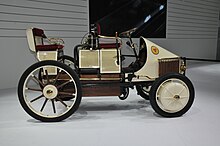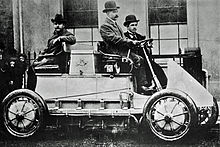Lohner-Porsche
Lohner-Porsche is the collective name for vehicles with an electric drive from Lohner-Werke . The vehicles are called Lohner-Porsche Semper Vivus and Mixte-Wagen , but are often referred to as Lohner-Porsche electric vehicles or just Lohner-Porsche . The vehicles were developed by Ludwig Lohner and Ferdinand Porsche . The automobiles were equipped with gasoline and electric motors. The Mixte car was a hybrid vehicle . A custom-made model with all-wheel drive was also built . This can be seen as the first automobile with all-wheel drive in the history of the automobile . The vehicle was first built in 1899 and presented to the public at the Paris World Exhibition in 1900 .
history
The Lohner-Werke in Vienna-Donaustadt were the purveyors to the court of the Austro-Hungarian monarchy . Ludwig Lohner took over the “Jacob Lohner & Co., Vienna” court wagon factory in 1887 from his father Jakob Lohner . Ferdinand Porsche developed a wheel hub motor as part of his order from Ludwig Lohner, with which he moved to the Lohner works in 1897. Until 1899, Lohner and Porsche jointly developed and built the “Lohner-Porsche System” electric vehicle, and presented it at the Paris World Exhibition in 1900 as the first transmission-free car and epoch-making technical innovation. Also in 1900, Ferdinand Porsche developed a hybrid vehicle with a mixed gasoline-electric drive at Lohner, which eliminated the disadvantage of the insufficient range of the battery-operated electric vehicle and was produced as a passenger and commercial vehicle.
The end of the "Lohner-Porsche" era was in 1906. The production of the Lohner-Porsche vehicles was given up due to a legal dispute over the patent and excessive development costs. Ferdinand Porsche has made a good reputation as a designer and inventor through the Lohner-Porsche construction. He left the Lohner company and took a position as technical director and chief designer at Austro-Daimler .
The Porsche Museum in Stuttgart carefully recreated the Semper Vivus in a four-year project and presented it for the first time at the Geneva Motor Show in March 2011. Today the replica is part of the collection of the Porsche Museum in Stuttgart.
developments
Lohner's reason for a vehicle with an electric motor was that the air was "mercilessly spoiled by the large numbers of petrol engines" .
Vehicle with a pure electric motor
In 1899 an electric vehicle was built, which Porsche presented as “Semper Vivus” (“Always Alive” or “Always Alive”) at the Paris World Exhibition in 1900. The car known today as the “Lohner-Porsche” was registered with the Austrian Patent Office under the number 19645. A “drive steering wheel with electric motor” was registered in the patent specification. It had a precise form of drive for the front wheels that was free of any effects on the steering. This was only possible a few decades later for vehicles with internal combustion engines . The vehicle had a top speed of around 50 km / h and a range of 50 km with the 410 kg lead-acid battery .
One of the first all-wheel drive vehicles

In the same year, in 1900, a special production was designed and built for a Brit named EW Hart; other sources also give the year 1902. Porsche mounted a wheel hub motor with an output of 1.5 kW on each of the rear wheels of the vehicle . It was thus one of the first all-wheel drive vehicles in the world. In order to create a greater range , the mass of the batteries was increased from 410 kg to 1800 kg. The vehicle is said to have reached a speed of 60 km / h and an efficiency of 83%.
One of the first hybrid vehicles
In 1902, the greatest weakness of the vehicles was recognized. They were too heavy and therefore had too little range. Porsche therefore redesigned the vehicle. A hybrid electric vehicle was created . Porsche called the vehicle Mixte-Wagen because the battery was charged with the help of a Daimler combustion engine . The vehicle had only one front wheel drive.
Use and well-known owner
The Vienna fire brigade owned 40 vehicles that were powered according to the Lohner-Porsche principle. In Berlin and other cities, Lohner-Porsche cars were used as taxis . Since the vehicles cost around 10,000 to 35,000 Austrian crowns , which at the time was quite a lot compared to vehicles with internal combustion engines , only wealthy people could afford a Lohner-Porsche. In total, only 300 vehicles were produced. Well-known owners were the dealer Julius Meinl , Margrave Sandor Pallavicini , Prince Egon zu Fürstenberg , chocolate manufacturer Ludwig Stollwerck and the Baron Nathan Rothschild . The Lohner-Porsche vehicles could not prevail because of their short range.
Individual evidence
- ^ German biography: Porsche, Ferdinand . Retrieved November 21, 2017
- ↑ Reinhard Seiffert: The genius and his mission for a technology that did not prevail. Ferdinand Porsche and the Lohner-Porsche: With front-wheel drive and wheel hub motors ( Memento from March 31, 2008 in the Internet Archive ) In: Frankfurter Allgemeine Zeitung No. 125, May 30, 2000, p. T4.
- ^ Franz Straka: Ära Lohner: From the coach to motorization In: strassenbahn-europa.at, December 2007. (accessed on October 27, 2011)
- ↑ Porscheplatz: The Semper Vivus . June 22, 2012. Retrieved November 21, 2011
- ↑ Porsche Hybrid Vehicles In: www.porsche.de (accessed April 23, 2018)
- ↑ Günter Weigel: Hubert Drescher recreated the Semper Vivus - 111 years ago it was the first hybrid car in the world: A clumsy avant-garde In: www.berliner-zeitung.de, April 2, 2011. (accessed October 28, 2011)
- ↑ Lohner-Porsche In: autowallpaper.de (accessed on October 26, 2011)
- ^ A b c Michael Hereward Westbrook (Ed.): The Electric Car: Development and Future of Battery, Hybrid and Fuel-cell Cars , IET, 2001, ISBN 978-0-85296-013-4 . P. 16 ff.
- ↑ Christoph Prantner: The first eco-car In: www.planet-wissen.de, June 1, 2009 (accessed October 26, 2011)
- ↑ Porscheplatz: Evolution sports car all-wheel drive . Offline .
- ↑ Porsche and not Toyota is the hybrid pioneer in FAZ on August 10, 2010, page T4
- ↑ Lohner-Porsche electric vehicle, 1900. In: www.technischesmuseum.at (accessed on November 12, 2011)
- ↑ Lohner Porsche: Turned on the big wheel. In: www.spiegel.de, April 14, 2000 (accessed November 12, 2011)
literature
- Reinhard Osteroth: Ferdinand Porsche: The pioneer and his world . Rowohlt, Munich 2004, ISBN 3-498-05036-2 , p. 302 .
- Porsche Museum , Stuttgart: Ferdinand Porsche - Pioneer of the Hybrid Automobile / Hybrid Automobile Pioneer , German / English. Edition Porsche-Museum, Stuttgart 2010, ISBN 978-3-9812816-4-4 .
- Association of German Engineers (ed.): History of technology . tape 55 , 1988.




